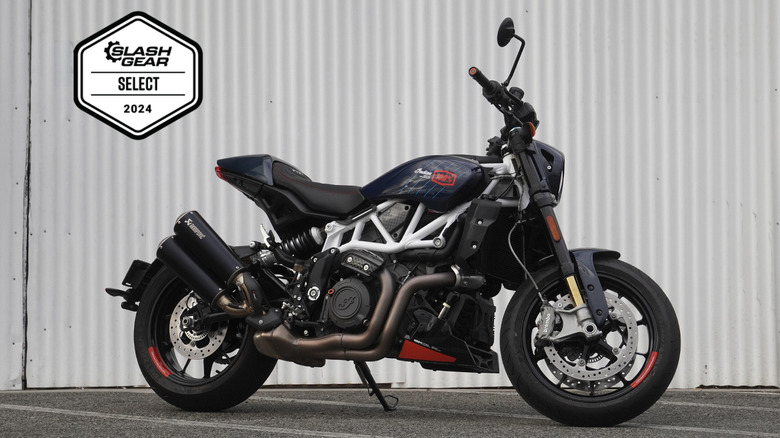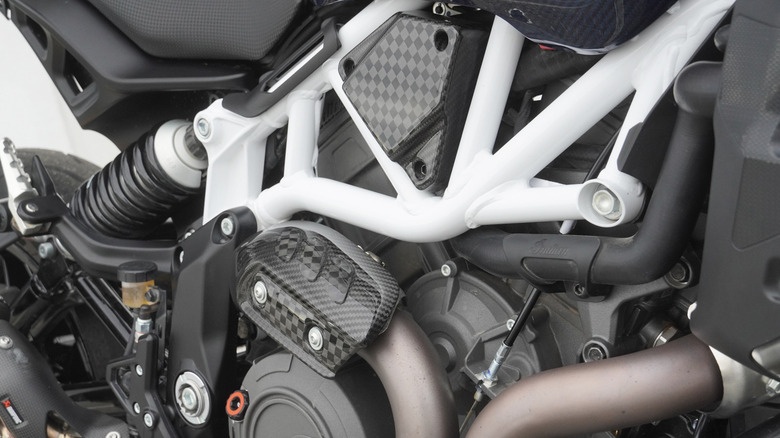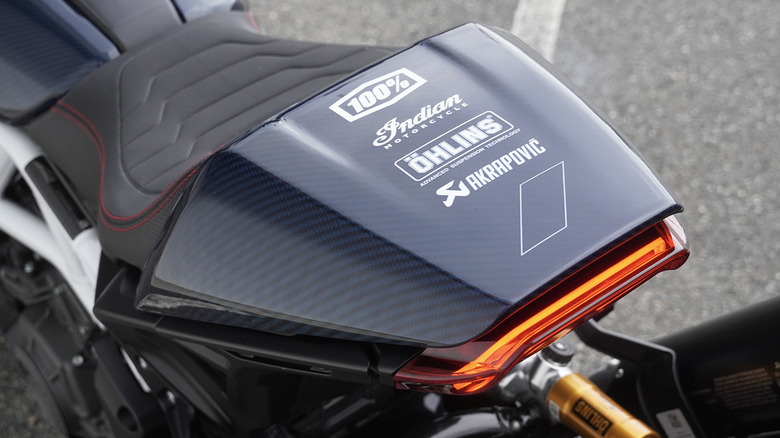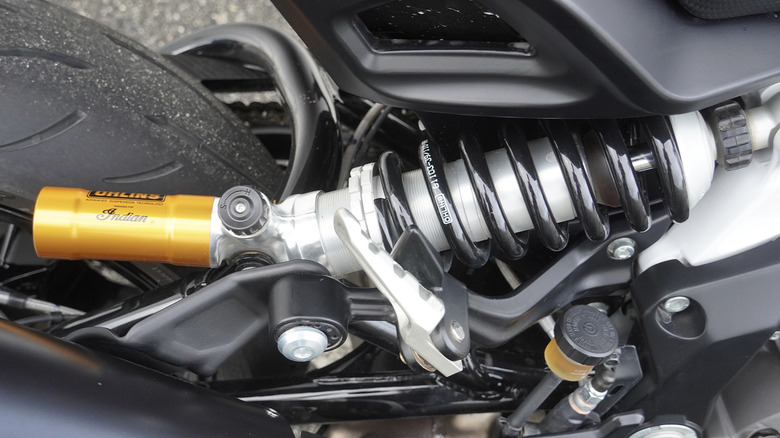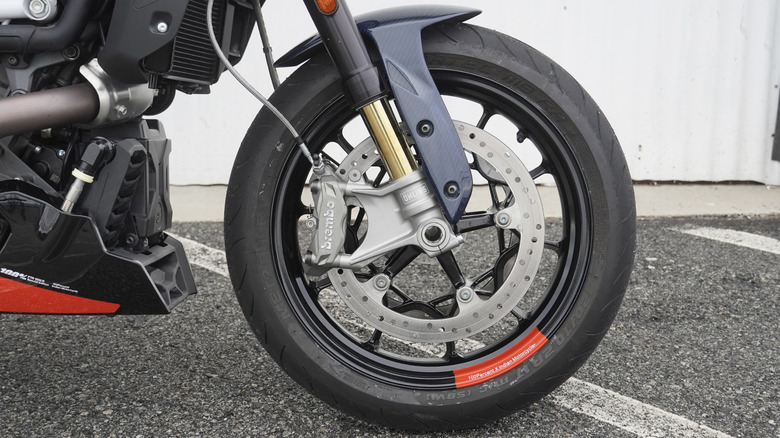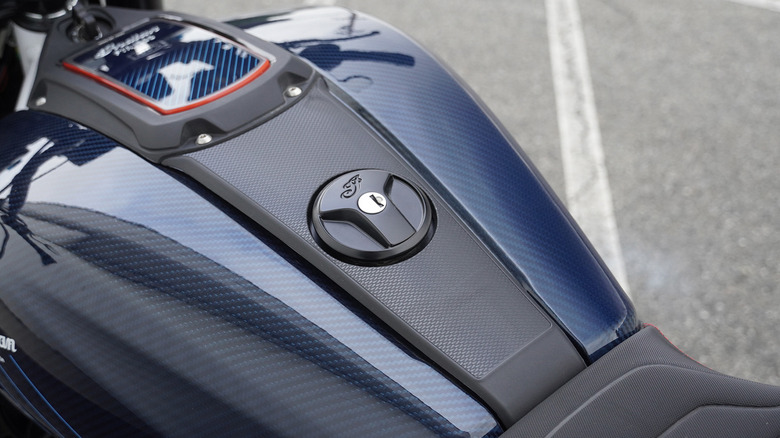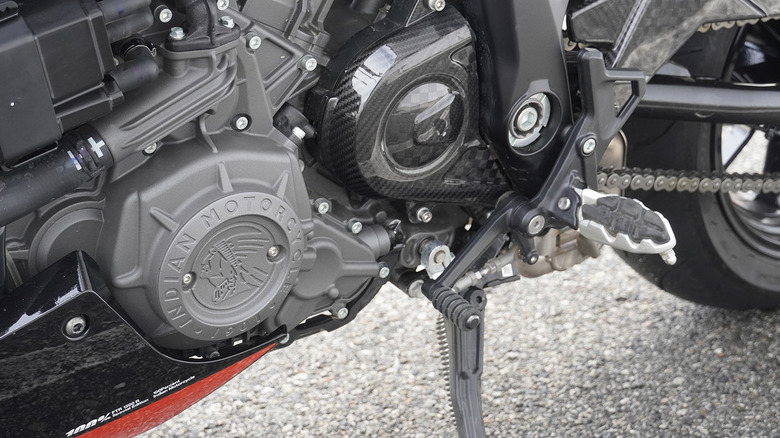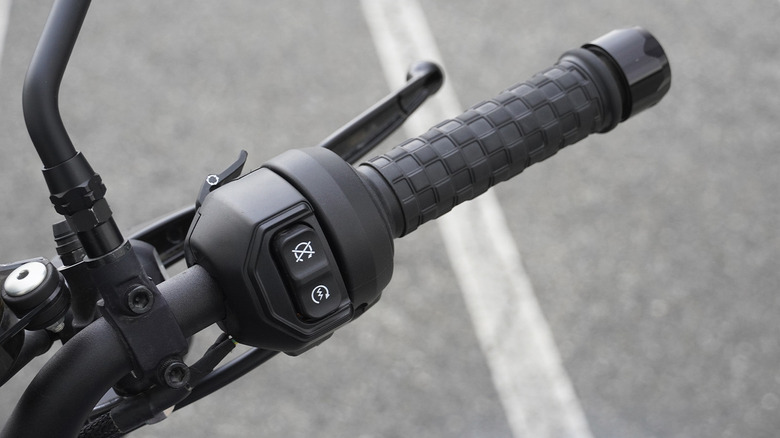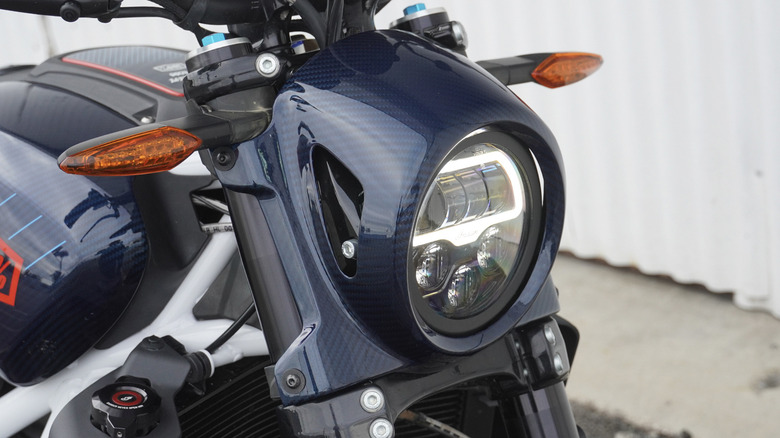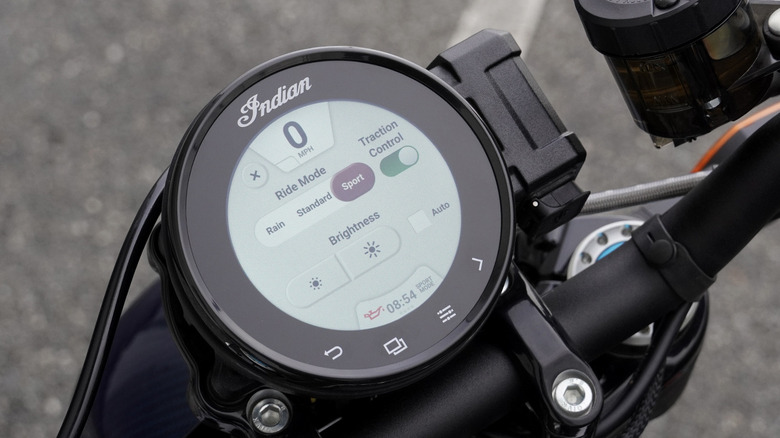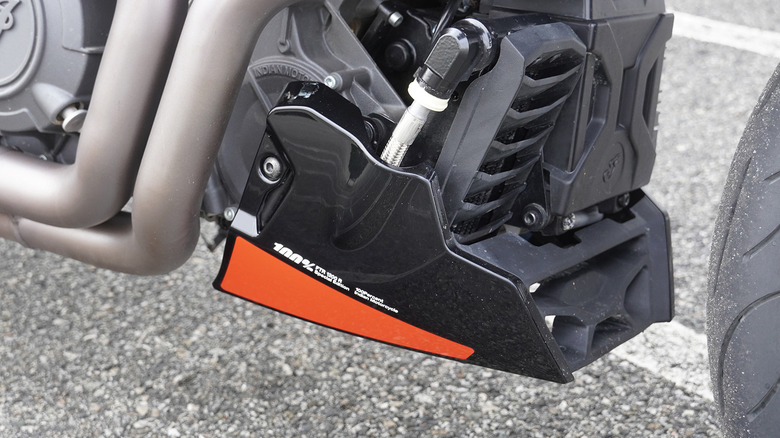2024 Indian FTR X 100% R Carbon Review: Rarity & Expense Don't Bring What You'd Expect
- Almost all the carbon fiber possible
- Effectively masks weight with a low center of gravity
- Spectacular Öhlins suspension
- Not quite all the carbon fiber possible
- Heavier than most other nakeds
- Not quite as much power as expected from 1,203cc
Back in 2019, Indian Motorcycle jumped unexpectedly into the naked bike category with the debut of the FTR. A flat track-inspired design, complete with the de-rigeuer trellis frame, definitely looked the part. Throw in the appeal of real liter-bike status and the recipe seemed surefire—but still, nobody expected Indian to crank out such a great naked that leaves almost every aspect of cruiser culture behind.
Now five years in, Indian already introduced something of a second generation that worked over the FTR with a few additional refinements including a remapped ECU, smaller wheels, and narrower handlebars. For 2024, the lineup now includes an FTR x 100% R Carbon package, a limited-edition version of the formerly top-spec R Carbon with a starting price tag of $18,999 and a production run held to only 400 bikes.
I can admit that when I think of Indian, hogs and Harleys come to mind, or the King of the Baggers racing series, rather than a lightweight, nimble daily rider. So the concept of a naked fully decked out in carbon seems somewhat counter to the company's ethos. And stepping further upmarket amid the eternally expanding segment might seem counterintuitive, too, especially since the FTR almost singlehandedly carries on the true naked trellis style that Ducati inaugurated with the Monster in the 1990s. Suffice to say, when FTR x 100% R Carbon #000 out of 400 pulled up outside my apartment for a month of testing in a surprisingly wintry Los Angeles, the surprises just kept rolling in.
All carbon everything, or at least almost everything
Fresh off pre-running the Baja 1000 and facing two immediate back-to-back drive programs, I can also admit that I did exactly zero research before receiving the FTR, my first Indian ever. All I knew about the bike could be summed up in a few words. And honestly, the first thing I noticed was that not all of the bike was built of carbon fiber.
No, I never expected a trellis frame built out of the miracle material. But plenty of trim pieces still finished in plastic surprised me nonetheless. Turns out, 100% refers not to every last little piece of carbon used, but instead a motocross gear company. Hence the "x" in "Indian FTR x 100% R Carbon" I suppose. Using the nomenclature harkens to flat-track style, rather than the fact that the former range-topping R Carbon also received less than a comprehensive carbon treatment.
Still, the 100% R Carbon's carbon looks absolutely awesome, with a dark-blue weave that reminded me of the first (and only) Bugatti I drove this past summer in France. Like that Chiron Super Sport, though, the 100% R Carbon commands a pretty penny, and somehow weighs a surprising 518 pounds wet—more, to be clear, than a base FTR non-carbon.
Details to justify a significant price bump
The slightly-less-carbon'ed FTR R Carbon, meanwhile, weighs the same, with a classic dark grey carbon weave contrasted with a maroon frame and tank stripe. That bike also weighs 518 pounds wet and starts at $17,249 without an optional Akrapovic exhaust fitted, which the 100% R Carbon does receive standard. Getting confused yet?
The rest of the 100% package includes a carbon pillion cover with partner company decal badges, a few pieces of exhaust and engine trim, a chain cover, and blacked out Öhlins forks instead of the Swedish suspension company's typical gold finish. Cutting back on flashy colors up front better complements the rest of the bike's blue carbon, but when trying to compete against more exotic nakeds from Ducati or Aprilia, restraint might not be the best plan here.
Öhlins suspension smooths out road surfaces
Luckily, those Öhlins also represent the single biggest surprise of my whole time with the 100% R Carbon. Because, to combat the nimble Italian screamers, Indian achieved nothing short of a miracle with the FTR's suspension dynamics. Despite weighing about 100 pounds more than a Streetfighter V4 SP—not a random example, if not entirely fair given the radically divergent price points—the FTR rides so much lighter than expected.
Engineering comes into play, without a doubt. See that gas tank wrapped in blue carbon and draped over the white trellis? That's not a gas tank. Instead, like a MotoGP bike or flat-track racer, the FTR stores fuel in a cell below the seat to keep the bike's center of gravity as low as possible. But even so, my mind continually balked at how easy this bike is to ride.
No carbon wheels on this Indian
The Öhlins dampers arrived perfectly tuned for my weight and preferences, just this side of firm but still able to smooth out bumps and cracks in the road without any sense of wavy vagueness. Bikes this dialed in sometimes weird me out, as accustomed as I am to taut and uncomfortable crotch rockets or carbon-fiber road bicycles with zero suspension other than 23c tires. In fact, I remembered back to my first ride in Topanga on the Streetfighter V4 SP, when I stopped to make sure the rear tire hadn't gone flat because the carbon-fiber wheels absorbed so much road chatter.
Not that the 100% R Carbon comes with carbon-fiber wheels—not at under $20,000 anyway, even if that number for an Indian naked seems high—just that the ride quality approaches a similar level of startling smoothness. In town, the perfect damping creates a comfortable ride while commuting. But where I noticed early into the loan that Indian placed the foot pegs a bit more rearward compared to other commuters, once out in Topanga, the FTR's second personality entered the conversation.
Scooting out on an upright naked
I took one of the same ride routes as on that SF V4 SP last year, thanks to something of a whim but mostly because recent rains rendered many canyons full of rocks and even running streams that I wanted to avoid. But the decision proved apt once I started leaning into the canyon carving that, somehow, the FTR absolutely nails. Despite the borderline cruiser riding position and high, narrow bars, somehow the pegs let me sidle out onto each thigh perfectly upright, hanging off the oversquare seat in a low squat much more confidently than other top-tall bikes I've ridden.
Then, because the weight rides low, too, scooting my tail to the rear of the seat pad kept my positioning from sending all semblance of balance akimbo. Call it a few miles an hour faster through corners I know good and well, despite the iffy surfaces, but the sensation of rolling through at speed left other retro-inspired or ADV bikes in the dust.
Equally comfortable commuting or canyon carving
That upright posture and suspension definitely makes the FTR a great commuter. And the FTR's 31.7-inch seat height, despite the wide platform clearly catering for American rear ends, also let me flat-foot easily as stoplights. But the Ride Command touchscreen, which uses technology shared with other Polaris vehicles, further sets the FTR apart. No more fiddling with grip buttons—still present, to keep hands on bars as much as possible—while switching between ride modes or gauges screens. Instead, even while wearing thick wintry gloves, the interface snapped between pages quickly (other than at startup, when the screen takes a few more moments than I'd have liked to boot up).
In traffic or on the freeway, the 1,203cc twin puts out plenty of pull throughout the rev range. Indian claims 87 lb-ft of torque and I believe the figure, especially at lower RPMs. But out ripping through the hills, the engine just doesn't build up in power as much as other liter bikes. Here, maybe the miracle of masked weight simply can't compensate enough, resulting in linear shove from 120 horses rather than the kind of ramping acceleration reserved for scarier nakeds, including even the base Streetfighter V2.
The rest of the stellar ride deserves better, given the frequency with which I hit full throttle. We're not slow, make no mistake, just not quite as raucous as expected. Another surprise: the 100% R Carbon's standard upgraded exhaust must be the quietest system that Akrapovic ever built. Louder would be nice, in my humble opinion, and might unleash that twin a bit more while covering up some of the clutch whine that emerges at idle and low load riding. If "loud pipes save lives" as claimed, then more burble, rather than hints of chop and clatter, sounds all the better.
Light controls for smooth riding
Part of the surprising confidence with which the FTR begs for more speed comes down to the feathery controls. Faux woven-leather grips and light levers keep both clutch and braking action on the floaty side of the spectrum, helped no doubt by a slipper/assist clutch and four-piston Brembos up front. Minimal engine braking helps to prevent sharp weight transfer fore and aft, too—okay, maybe more heft also means more momentum to prevent lurching.
In the Normal or Rain riding modes, that throttle twists smoothly to match the Öhlins suspension, but wakes up big time in Sport where far less physical crankage brings out the same quick bark and hustle. By the end of a few weeks, I kept the FTR in Sport at all times, actually, to play up the hooligan nature a bike with this kind of brash style by nature produces. Apologies to everyone I ripped past on the PCH, I guess. At least the Indian looked good doing so.
Different strategies in the naked bike segment
Other than in terms of straight-line acceleration, the FTR's heft showed up mainly while playing Tetris in my tiny garage. Pushing up a slight incline required way more muscle and careful balance than expected after the surprisingly easy riding, but leaning over on the kickstand next to my 2006 Monster S2R 1000 also revealed the stark difference in sheer size more typically attributable to Indian's more expected cruisers.
Wider and lower, the white trellis also stands out in the garage—especially next to my all-black Monster but in contrast with the brand-new 2024 Monster Plus I gave back only a few days before receiving the FTR. As with most naked bikes from other manufacturers, Ducati dropped the trellis that made the Monster such an icon. A big bummer, for sure, to Monster enthusiasts but a real consideration to evolving technology, weight savings, and even insurance coverage. Turns out, bikes with more advanced chassis designs get totaled far less frequently.
The Indian's lack of a windscreen also caught my eye because I noticed quickly while riding on the freeway how little wind buffeted my facemask at (and above) 80 miles an hour. Somehow, the front fender and headlight housing whipped any air above my head entirely, aerodynamics that may also explain why a relative lack of gnarly acceleration at top speeds left me flummoxed. Out back, the rear fender looks a little silly, but does help with the tail's visual profile. Rather than a tail tidy, in this case maybe a tail license plate frame to allow for the rear fender delete might further wrap up the FTR's otherwise excellent design.
Some sticking points remain
Other little sticking points in my mind after a few weeks with the FTR x 100% R Carbon? Well, this nearly $20,000 bike comes with a touchscreen and cruise control, but no heated grips. And as temps dropped in Los Angeles to—gasp!—the high-40s at night, early morning rides simply flitted into and out of my mind given the cold. I also regularly shifted into neutral from first until I programmed my brain to instruct my left foot with very purposeful movements. Again, the lightweight controls in action, which otherwise helped hide so much of the poundage but possibly led to a few badly timed mis-shifts in traffic and while canyon carving.
Overall, though, I can confirm what everyone knew before me: With the FTR, Indian definitely cranked out an unexpected classic. Any preconceived notions about my first Indian went right out the window as I thoroughly enjoyed my time with the 100% R Carbon. Now, whether that price bump makes any sense comes entirely down to taste.
A lot to like on my inaugural Indian
Even a "base" FTR R Carbon features everything I liked most, mechanically speaking, about the bike. And a base Streetfighter V2—what many, including myself, consider the original Monster's more appropriate modern successor than the current Monster—costs a bit less while delivering a much more radical and tactile machine-rider union, nonetheless still combining daily rider and canyon carver personas even better.
For the selvedge jeaned crowd looking to stand out, maybe tacking a bunch of carbon fiber onto a classis works wonders (and the cyclist in me sure appreciates carbon in any form). The rarity of a one-in-400 build number may come into play for potential collectors, but we're far past Yamaha, Honda, or Kawasaki here, so will potential collectors really want to spend Ducati, Aprilia, or even Triumph money on an Indian? Throwing in a pair of similarly branded sunglasses can only go so far.
But as I can admit, once again, equally as much about my own Monster S2R 1000, we all know that looking back at the bike while walking away plays a big part in a purchase process. And rationalization always beats real logic anyway, so for the right buyer, that dreamy blue weave might just make all the difference in the world.
